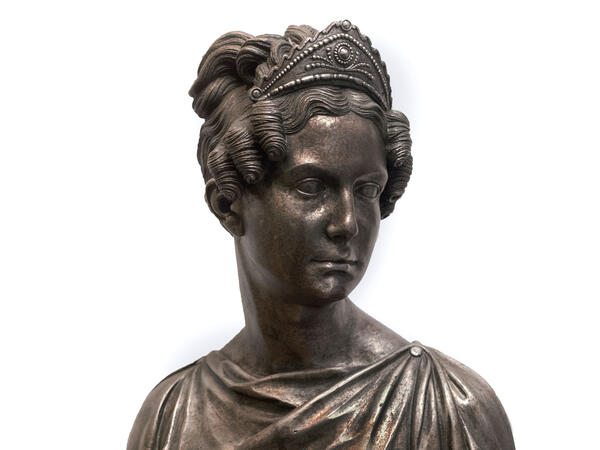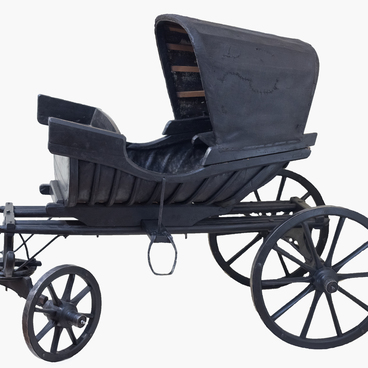A portrait sculpture of Empress Alexandra Feodorovna, the wife of Emperor Nicholas I, was based on the work of the German sculptor Christian Daniel Rauch. He created this bust in 1816 in Berlin. At that time, the Prussian Princess Friederike Luise Charlotte Wilhelmine — this was the name of the Empress before the adoption of Orthodoxy — was the bride of Grand Duke Nicholas Pavlovich.
Daniel Rauch was born in 1777 in the German city of Bad Arolsen. The parents of the future sculptor were not rich and could not apprentice him to a sculptor in the capital, so Rauch first studied with sculptors in the city of Waldeck and then in Kassel.
In 1797, Rauch came to Berlin and became a valet — he began to serve the Prussian king Frederick William II. After the king died, Rauch continued his service at the court of the king’s heir Frederick William III.
The young king and his wife, Queen Louise, did not forbid him to create sculptures and encouraged his further studies. Rauch studied with the sculptor Johann Gottfried Schadow, a follower of Classicism, who headed the court workshop. In 1803, Rauch created a portrait bust of Queen Louise, after which the royal couple sent him to Rome to study carving marble so that the artist would be able to copy his work in this material. However, in 1810, Queen Louise died, and the sculptor was called back to Berlin to participate in a competition for the best tombstone. The design he submitted was considered the best. In 1812, Rauch went to Italy again to make this monument in marble. The sculpture was installed in 1814 in the mausoleum built for it in Charlottenburg. The author’s copy of the monument head is housed in the Hermitage.
In 1815–1822, Rauch made marble statues of Prussian generals Gerhard von Scharnhorst and Karl Wilhelm Paul von Bülow commissioned by the king. They were started in Carrara, which was famous for its white marble. By 1824, Rauch created about 70 portrait busts, including those of Grand Duke Nicholas Pavlovich and his wife Alexandra Feodorovna. By order of Nicholas I in 1839, he created a marble statue “Danaid” — it was given as a gift to the Russian Empress.
The portrait bust of Alexandra Feodorovna was cast at the Alexandrovsky Plant in Petrozavodsk. In the 18th century, cannons and cannonballs were produced there, mainly for the fleet. The plant not only made military products but was also produced cast artistic works. Cast-iron railing, animal figures, oven shutters, openwork vases were sent to St. Petersburg. The plant’s products can still be found in Saint Petersburg, its suburbs, and Petrozavodsk.
Daniel Rauch was born in 1777 in the German city of Bad Arolsen. The parents of the future sculptor were not rich and could not apprentice him to a sculptor in the capital, so Rauch first studied with sculptors in the city of Waldeck and then in Kassel.
In 1797, Rauch came to Berlin and became a valet — he began to serve the Prussian king Frederick William II. After the king died, Rauch continued his service at the court of the king’s heir Frederick William III.
The young king and his wife, Queen Louise, did not forbid him to create sculptures and encouraged his further studies. Rauch studied with the sculptor Johann Gottfried Schadow, a follower of Classicism, who headed the court workshop. In 1803, Rauch created a portrait bust of Queen Louise, after which the royal couple sent him to Rome to study carving marble so that the artist would be able to copy his work in this material. However, in 1810, Queen Louise died, and the sculptor was called back to Berlin to participate in a competition for the best tombstone. The design he submitted was considered the best. In 1812, Rauch went to Italy again to make this monument in marble. The sculpture was installed in 1814 in the mausoleum built for it in Charlottenburg. The author’s copy of the monument head is housed in the Hermitage.
In 1815–1822, Rauch made marble statues of Prussian generals Gerhard von Scharnhorst and Karl Wilhelm Paul von Bülow commissioned by the king. They were started in Carrara, which was famous for its white marble. By 1824, Rauch created about 70 portrait busts, including those of Grand Duke Nicholas Pavlovich and his wife Alexandra Feodorovna. By order of Nicholas I in 1839, he created a marble statue “Danaid” — it was given as a gift to the Russian Empress.
The portrait bust of Alexandra Feodorovna was cast at the Alexandrovsky Plant in Petrozavodsk. In the 18th century, cannons and cannonballs were produced there, mainly for the fleet. The plant not only made military products but was also produced cast artistic works. Cast-iron railing, animal figures, oven shutters, openwork vases were sent to St. Petersburg. The plant’s products can still be found in Saint Petersburg, its suburbs, and Petrozavodsk.



